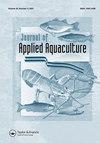不同放养密度下尼罗罗非鱼幼鱼的生长、消化酶活性、近似组成和血液生化反应
IF 0.8
Q3 FISHERIES
引用次数: 1
摘要
本文章由计算机程序翻译,如有差异,请以英文原文为准。
Growth, digestive enzyme activities, proximate composition and hemato-biochemcial responses of juvenile Nile tilapia (Oreochromis niloticus) reared at various stocking densities in a recirculatory aquaculture system
ABSTRACT This investigation aimed to assess the impact of rearing biomass on growth, digestive enzyme activity, and hematobiochemical indices of Nile tilapia in a tank-based recirculatory aquaculture system (RAS) for 90 days. Oreochromis niloticus (35.5 ± 0.24 g) were randomly stocked at the following densities: 80 fish/m3 (F80), 120 fish/m3 (F120), and 160 fish/m3 (F160) in triplicate. Ammonia, nitrate, nitrite, and CO2 were increased significantly as density increased and dissolved oxygen decreased (P < 0.05). A significantly increased weight gain, specific growth rate, growth efficiency, and protein efficiency ratio were recorded in F80 groups compared to F160 groups, whereas feed conversion ratio was decreased. Protease, amylase, and lipase activities were significantly lower as fish density increased. An improved (P < 0.05) red blood cell count, hemoglobin, and hematocrit were found in F160 groups. A considerably higher level of glucose, cortisol, triglycerides, total cholesterol, alanine, and aspartate aminotransferase were recorded in high-density tanks (P < 0.05). The crude lipid and carbohydrate contents were significantly lower in F160 groups. Hence, the outcomes of the present study indicated that stocking density 80 fish per m3 would be appropriate as it promotes the growth and health status of Nile tilapia cultured in RAS.
求助全文
通过发布文献求助,成功后即可免费获取论文全文。
去求助
来源期刊

Journal of Applied Aquaculture
Environmental Science-Ecology
CiteScore
3.20
自引率
0.00%
发文量
38
期刊介绍:
The Journal of Applied Aquaculture is a platform for the sharing of practical information needed by researchers to meet the needs of investors, farm managers, extension agents and policy makers working to adapt aquaculture theory to achieve economic and food security objectives in the real world. The journal emphasizes multi-disciplinary research and case studies that propose financially and logistically viable solutions to observable problems.
 求助内容:
求助内容: 应助结果提醒方式:
应助结果提醒方式:


